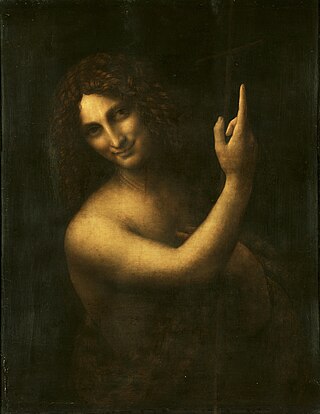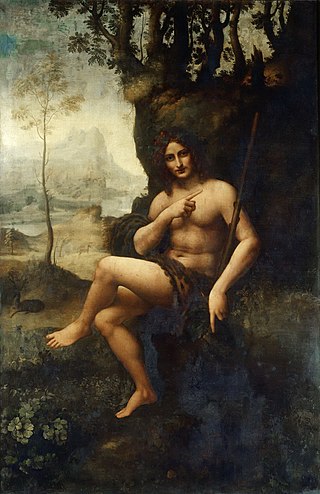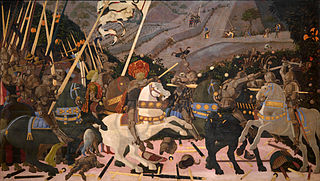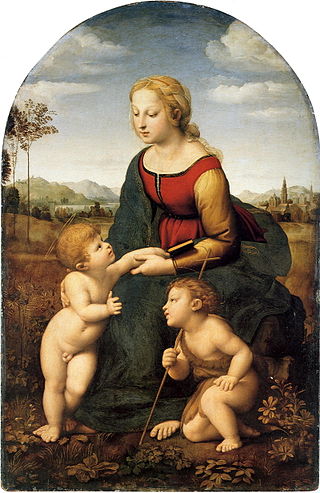
The Head of John the Baptist is a 1507 oil on poplar board painting by Andrea Solari, probably commissioned by cardinal Georges d'Amboise.

The Head of John the Baptist is a 1507 oil on poplar board painting by Andrea Solari, probably commissioned by cardinal Georges d'Amboise.
Signed and dated at bottom right, the image depicts the severed head of John the Baptist on a charger plate in which is a reflection, probably of Solari himself. [1]
The frame bears a seemingly original Latin inscription evoking John the Baptist. It is now in the Louvre in Paris, to which it was given by Eugène Lecomte in 1868. From 4 December 2012 to 11 March 2013 it was part of the temporary exhibition "Renaissance" at Louvre-Lens under catalogue number 25. [2]

The Louvre, or the Louvre Museum, is a national art museum in Paris, France. It is located on the Right Bank of the Seine in the city's 1st arrondissement and home to some of the most canonical works of Western art, including the Mona Lisa and the Venus de Milo. The museum is housed in the Louvre Palace, originally built in the late 12th to 13th century under Philip II. Remnants of the Medieval Louvre fortress are visible in the basement of the museum. Due to urban expansion, the fortress eventually lost its defensive function, and in 1546 Francis I converted it into the primary residence of the French Kings.

Antonio Allegri da Correggio, usually known as just Correggio, was the foremost painter of the Parma school of the High Italian Renaissance, who was responsible for some of the most vigorous and sensuous works of the sixteenth century. In his use of dynamic composition, illusionistic perspective and dramatic foreshortening, Correggio prefigured the Baroque art of the seventeenth century and the Rococo art of the eighteenth century. He is considered a master of chiaroscuro.

A caryatid is a sculpted female figure serving as an architectural support taking the place of a column or a pillar supporting an entablature on her head. The Greek term karyatides literally means "maidens of Karyai", an ancient town on the Peloponnese. Karyai had a temple dedicated to the goddess Artemis in her aspect of Artemis Karyatis: "As Karyatis she rejoiced in the dances of the nut-tree village of Karyai, those Karyatides, who in their ecstatic round-dance carried on their heads baskets of live reeds, as if they were dancing plants".

Liberty Leading the People is a painting by Eugène Delacroix commemorating the July Revolution of 1830, which toppled King Charles X. A woman of the people with a Phrygian cap personifying the concept of Liberty leads a varied group of people forward over a barricade and the bodies of the fallen, holding aloft the flag of the French Revolution – the tricolour, which again became France's national flag after these events – in one hand and brandishing a bayonetted musket with the other. The figure of Liberty is also viewed as a symbol of France and the French Republic known as Marianne. The painting is sometimes wrongly thought to depict the French Revolution of 1789.

The Virgin of the Rocks, sometimes the Madonna of the Rocks, is the name of two paintings by the Italian Renaissance artist Leonardo da Vinci, of the same subject, with a composition which is identical except for several significant details. The version generally considered the prime version, the earlier of the two, is unrestored and hangs in the Louvre in Paris. The other, which was restored between 2008 and 2010, hangs in the National Gallery, London. The works are often known as the Louvre Virgin of the Rocks and London Virgin of the Rocks respectively. The paintings are both nearly 2 metres high and are painted in oils. Both were originally painted on wooden panels, but the Louvre version has been transferred to canvas.

The Virgin and Child with Saint Anne is an unfinished oil painting by High Renaissance artist Leonardo da Vinci, dated to c. 1501–1519. It depicts Saint Anne, her daughter the Virgin Mary and the infant Jesus. Christ is shown grappling with a sacrificial lamb symbolizing his Passion as the Virgin tries to restrain him. The painting was commissioned as the high altarpiece for the Church of Santissima Annunziata in Florence and its theme had long preoccupied Leonardo.
Andrea Solari (1460–1524) was an Italian Renaissance painter of the Milanese school. He was initially named Andre del Gobbo, but more confusingly as Andrea del Bartolo a name shared with two other Italian painters, the 14th-century Siennese Andrea di Bartolo, and the 15th-century Florentine Andrea di Bartolo.

The Empire style is an early-nineteenth-century design movement in architecture, furniture, other decorative arts, and the visual arts, representing the second phase of Neoclassicism. It flourished between 1800 and 1815 during the Consulate and the First French Empire periods, although its life span lasted until the late-1820s. From France it spread into much of Europe and the United States.

Saint John the Baptist is a High Renaissance oil painting on walnut wood by Leonardo da Vinci. Likely to have been completed between 1513 and 1516, it is believed to be his final painting. Its original size was 69 by 57 centimetres.

Bacchus, originally Saint John the Baptist, is a painting in the Musée du Louvre, Paris, France, based on a drawing by the Italian Renaissance artist Leonardo da Vinci. It is presumed to have been executed by an unknown follower, perhaps in Leonardo's workshop. Sydney J. Freedberg assigns the drawing to Leonardo's second Milan period. Among the Lombard painters who have been suggested as possible authors are Cesare da Sesto, Marco d'Oggiono, Francesco Melzi, and Cesare Bernazzano. The painting shows a male figure with garlanded head and leopard skin, seated in an idyllic landscape. He points with his right hand off to his left, and with his left hand grasps his thyrsus and also points down to earth.

The Battle of San Romano is a set of three paintings by the Florentine painter Paolo Uccello depicting events that took place at the Battle of San Romano between Florentine and Sienese forces in 1432. They are significant as revealing the development of linear perspective in early Italian Renaissance painting, and are unusual as a major secular commission. The paintings are in egg tempera on wooden panels, each over 3 metres long. According to the National Gallery, the panels were commissioned by a member of the Bartolini Salimbeni family in Florence sometime between 1435 and 1460. The paintings were much admired in the 15th century; Lorenzo de' Medici so coveted them that he purchased one and had the remaining two forcibly removed to the Palazzo Medici. They are now divided between three collections, the National Gallery, London, the Galleria degli Uffizi, Florence, and the Musée du Louvre, Paris.

La Belle Jardinière, also known as the Madonna and Child with Saint John the Baptist, is a painting started by the Italian High Renaissance artist Raphael, and finished by Ridolfo del Ghirlandaio, that depicts the Madonna, a young Christ, and a young John the Baptist. It is believed to have been commissioned by the Sienese patrician Fabrizio Sergardi in approximately 1507. It is currently displayed in the Louvre Museum in Paris, France.
The Louvre-Lens is an art museum located in Lens, France, approximately 200 kilometers north of Paris. It displays objects from the collections of the Musée du Louvre that are lent to the gallery on a medium- or long-term basis. The Louvre-Lens annex is part of an effort to provide access to French cultural institutions for people who live outside of Paris. Though the museum maintains close institutional links with the Louvre, it is primarily funded by the Nord-Pas-de-Calais region.

The Madonna with the Blue Diadem is a painting by Raphael and his pupil Gianfrancesco Penni, and was most likely painted in Rome around 1510-1512, now at the Louvre. In the Louvre, the painting is named Virgin and Child with the Infant Saint John, also known as Virgin with the Veil or Virgin with the Blue Diadem. Additional names include Virgin with the Linen, Slumbering Child and Silence of the Holy Virgin.

La Scapigliata is an unfinished painting generally attributed to the Italian High Renaissance artist Leonardo da Vinci, and dated c. 1506–1508. Painted in oil, umber, and white lead pigments on a small poplar wood panel, its attribution remains controversial, with several experts attributing the work to a pupil of Leonardo. The painting has been admired for its captivating beauty, mysterious demeanor, and mastery of sfumato.

The Incredulity of Saint Thomas is a 1543–1547 painting by Francesco Salviati. It was commissioned for the église Notre-Dame-de-Confort in Lyon by Thomas II de Gadagne, a Florentine counselor to Francis I of France. It is now held in the Louvre Museum and measures 275 cm by 234 cm. It is signed FRANCESCO SALVIATO FLO. OPUS (S.B.D.) and the apostle shown in three-quarter-profile is a self-portrait of Salviati.

The Sant'Agostino Altarpiece is a painting by Perugino, produced in two stages between around 1502 and 1512 and then around 1513 to 1523. The altarpiece's 28, 29 or 30 panels were split up during the Napoleonic suppression of religious houses - most of its panels are now in the Galleria Nazionale dell'Umbria in Perugia. It is notable as the painter's last masterwork before he moved into his late phase producing more provincial commissions.

Rubin's Europe was a temporary exhibition at the Louvre-Lens which took place in the temporary exhibitions gallery from May 22 to September 23, 2013, following the inaugural Renaissance exhibition. The exhibition brought together 170 works by Pierre Paul Rubens and his contemporaries, the majority of which were on loan from other museums.

Interior of an Art Gallery is a 1637 oil on canvas painting by Cornelis de Baellieur, with the architecture and the paintings on the walls added by Hans Jordaens III. Alexandre Cart left it to the Louvre Museum in 1864 and it still hangs there as MI 699. It was exhibited at the Rubens' Europe exhibition at Louvre-Lens from 22 May to 23 September 2013.